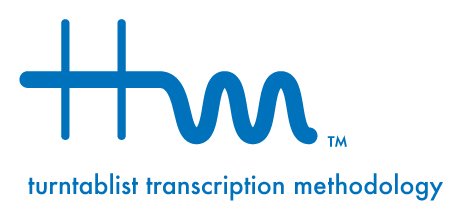
ADVANCED SCRATCH NOTATION:
FLARE, CRAB, ORBITS, ETC.
Many advanced scratches require breaking the sample sound with very rapid fader movement. Generally a turntablist will bounce the fader between the thumb and another finger (or several other fingers) to achieve this extremely rapid off and on motion. The very short break in the sound from the record is commonly referred to as a click. Simply put, a click is the break in the sound caused by the closing and opening of the fader in as little time as possible. Clicking is an essential technique for many advanced scratches and it requires a special notation.
Also crucial for understanding advanced scratches is the concept of the open-fader scratch.
Open-fader scratches are scratches that begin and end in the open (or on) fader position. Examples of open fader scratches include baby scratches, scribbles, flares, and orbits. The open fader scratches are unique in that the sound they produce includes the sound generated by the change of direction of the record during the back and forth scratching motion.
This sound is essential because at the exact point where the record changes direction, the record is momentarily completely motionless. This instance where the record is still, creates an extremely short period of silence -- a phantom click -- which breaks the sound of the scratch without requiring any movement of the fader. The phantom click is the reason that the swift back and forth motion of a baby scratch creates discrete bursts of sound.
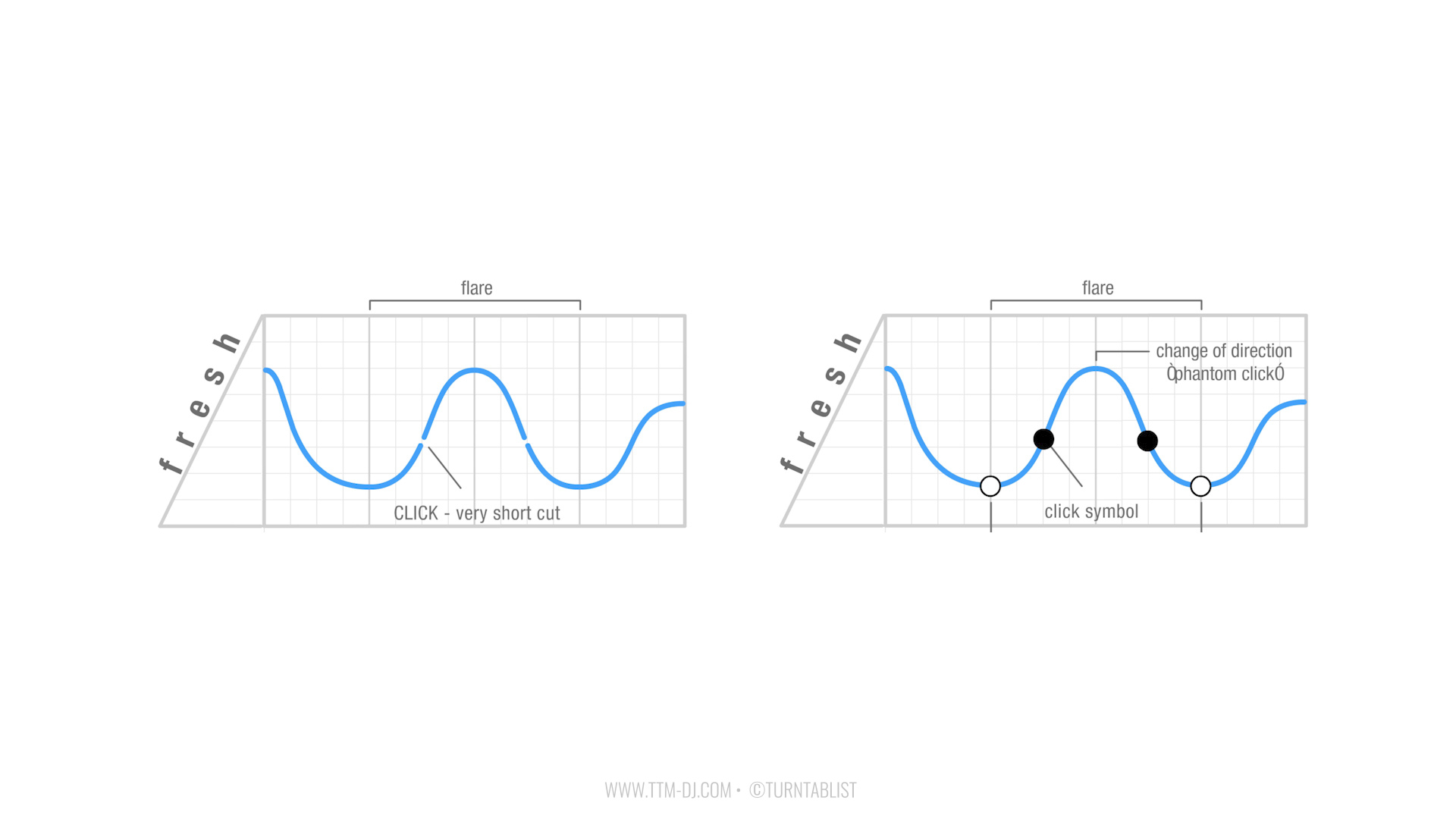
The flare is a good example of the impact of an open fader scratch. A flare begins with the fader open, and consists of a simple forward and back motion with the record. As shown in the diagram below, a click is placed in the middle of the push forward and another click is placed in the middle of the pull back. Unlike a chirp or a transformer, the change of direction of the record is heard. The resulting phantom click creates the illusion that the sample is being clicked twice as many times. In this flare, which has only two clicks, the phantom clicks make it seem as though there are four.
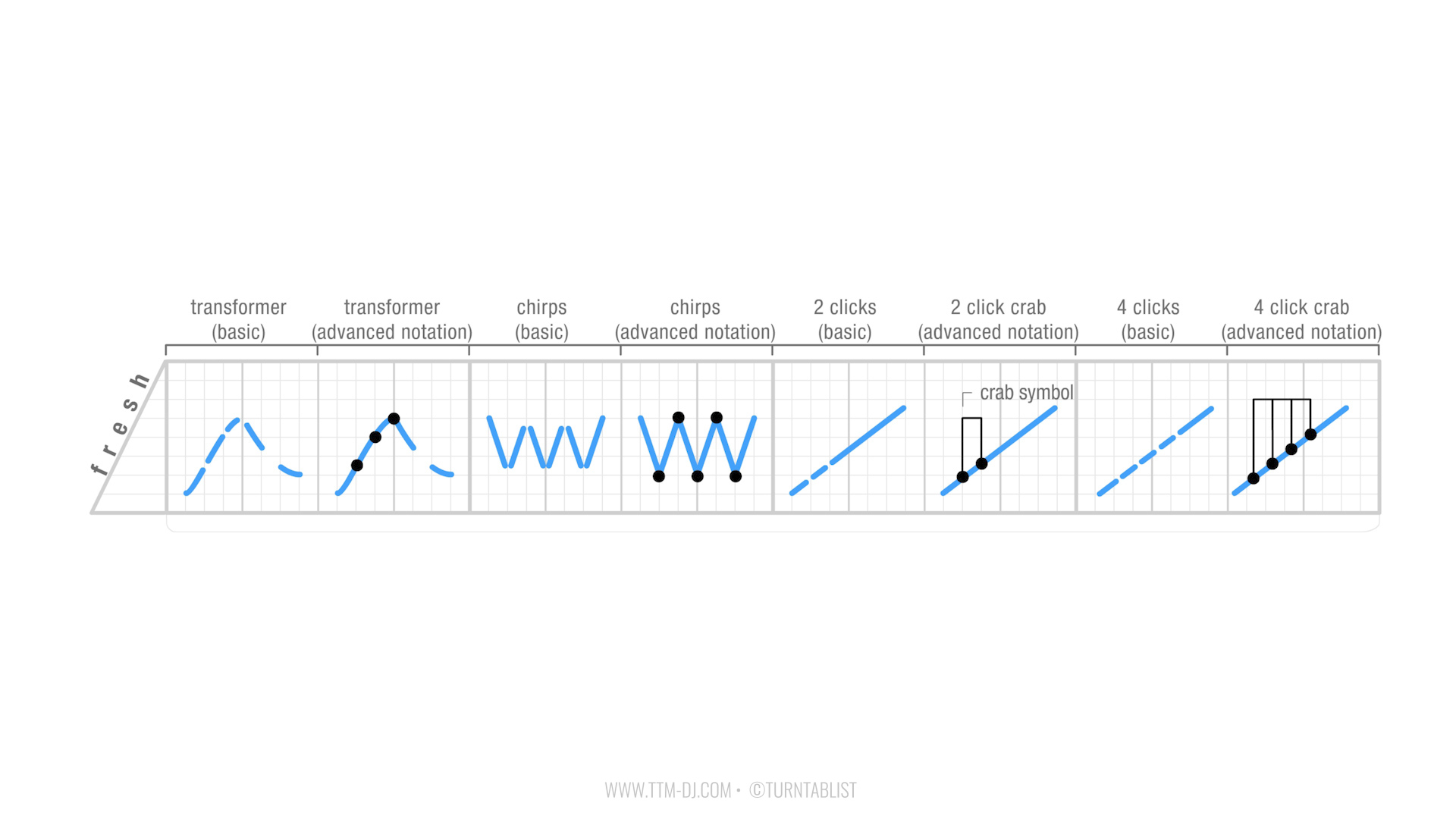
On the staff above are notations of closed fader scratches using both basic and advanced scratch notation. With these examples it becomes clear that there are advantages to using the advanced notation -- the clicks are both easier to read and to write.
Notice also the option of adding a crabbing symbol, as seen toward the far right. The crab, invented by DJ Q-Bert, is a mixer technique for producing a very rapid series of clicks. The key to the crab is to bounce the fader between the thumb and each of the other four fingers in sequence (pinky, ring, middle, pointer). The result is an extremely quick "four-click" scratch. Visually, the fingers produce a rolling motion that resembles a fast-crawling crab --if you're really realy stoned.
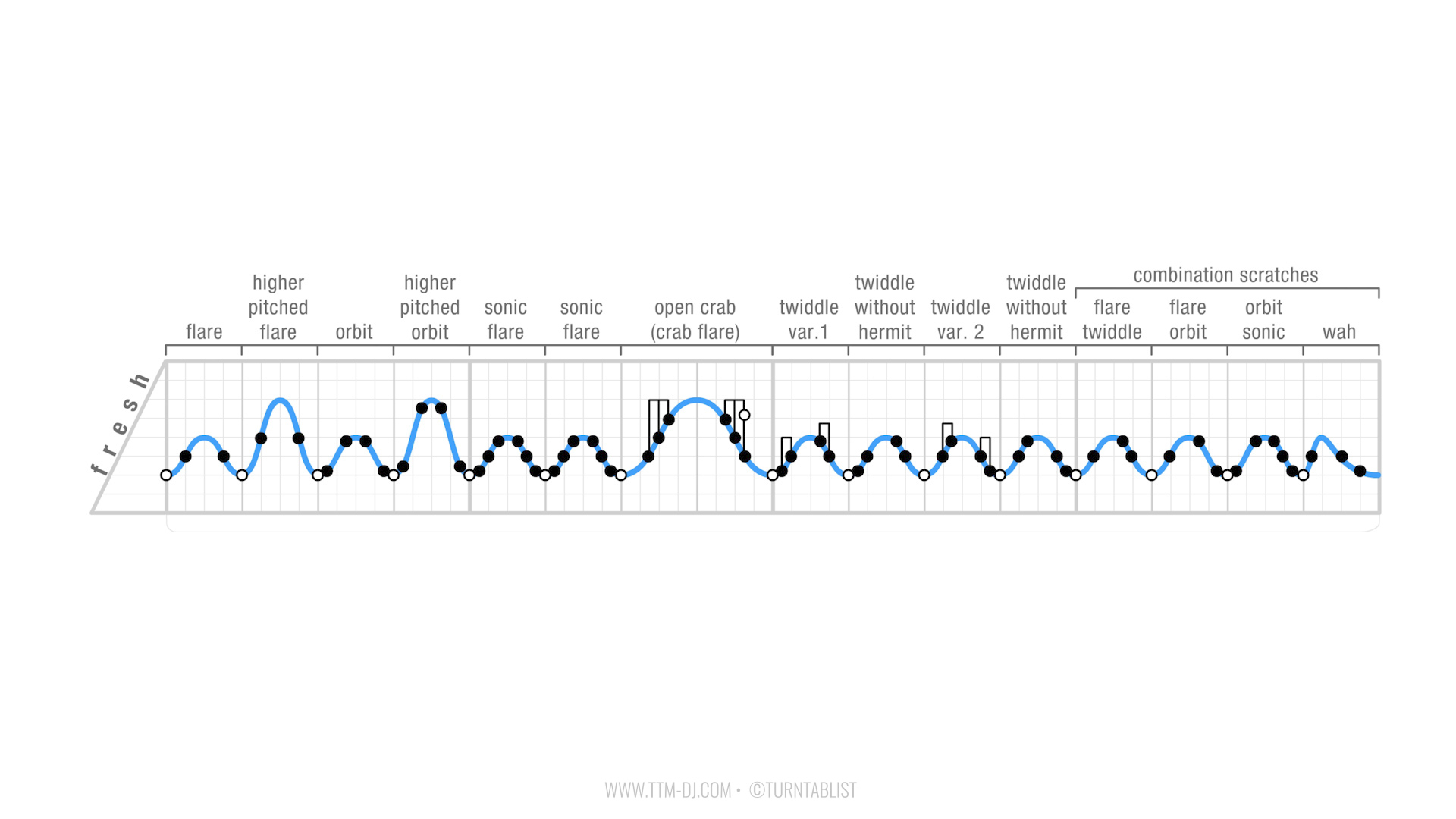
On the above staff are notations of open fader scratches using advanced scratch notation. Each of these scratches is separated by open fader symbols (optional). Since these scratches are connected to each other, they share their open fader symbols with their neighbors. Though in this case the open fader symbol doesn't signify an action on the mixer, it serves to break an incomprehensible sequence of clicks into an understandable series of standard scratches.
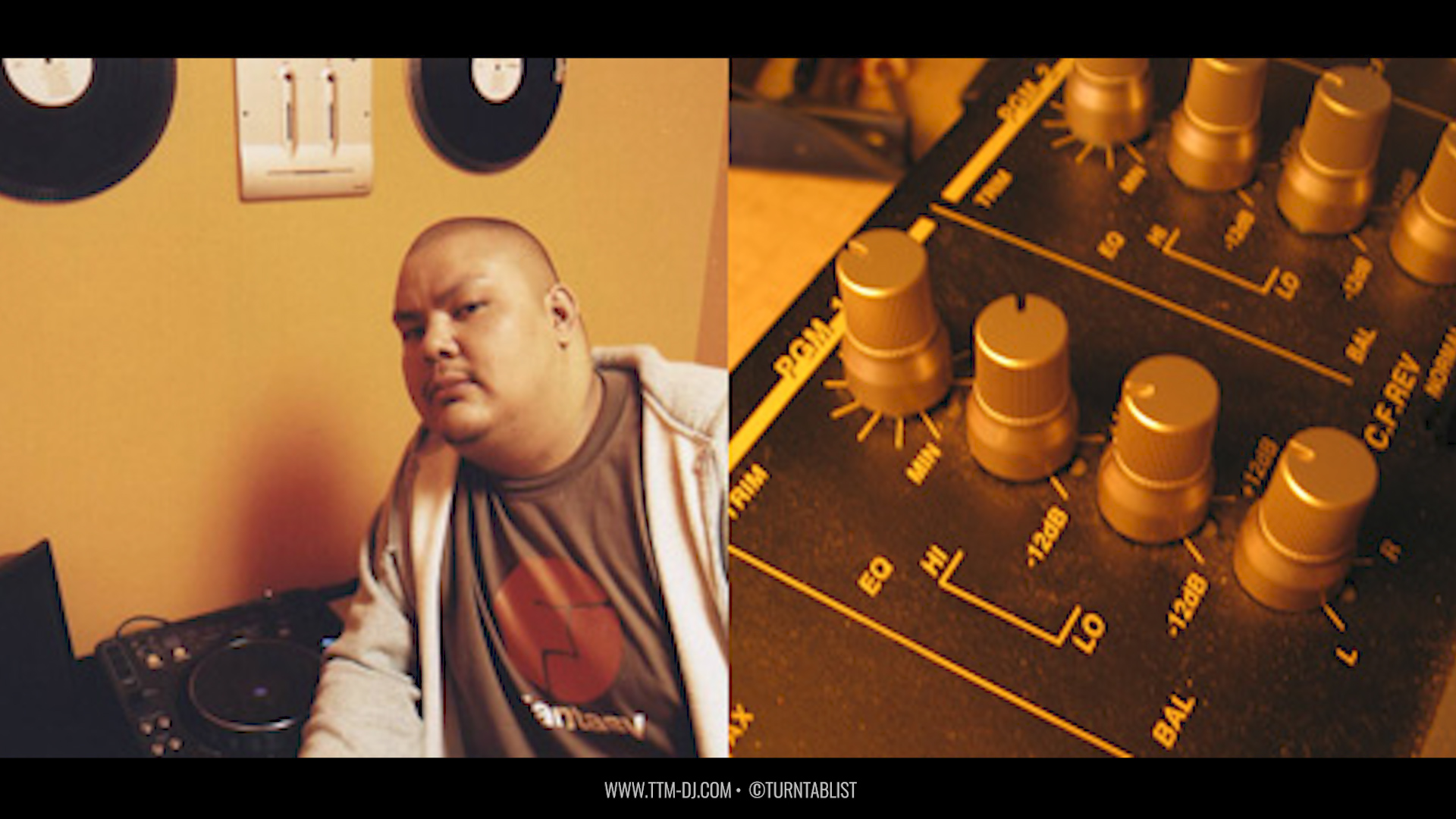
DJ TIP:
HOW TO EQ YOUR SCRATCHES with DJ EXCESS
( from Scratch Magazine 2005)
Having skills on the 1's & 2's is essential in rocking a show, but having a good ear to monitor and adjust for a clear on-stage mix is just as important. Here’s a few steps by DJ Excess to make your scratches pop out in the mix.
1. Right before I'm about to do my scratch solo, do headphone master cue.
2. Adjust the input gain for the for the sound you're scratching to
unity or 0 on your mixer's LED meter display.
3. Turn down the lows on your 3-band equalizer around -3 db
4. Move the record with the same force and motion you'd be using during your scratch solo. You want to further adjust the lows to take out as much hand thump pickup from your needle.
5. Turn up the mids around +3 db
6. Turn up the highs around +2 db. Be careful with adjusting your highs, cause nothing is worse than hearing high frequencies in headphones or in a loud sound system.
7. Slowly bring up your program fader to a level where the scratch sound stands out in the mix, but isn't overpowering.
Now you're ready to catch wreck!
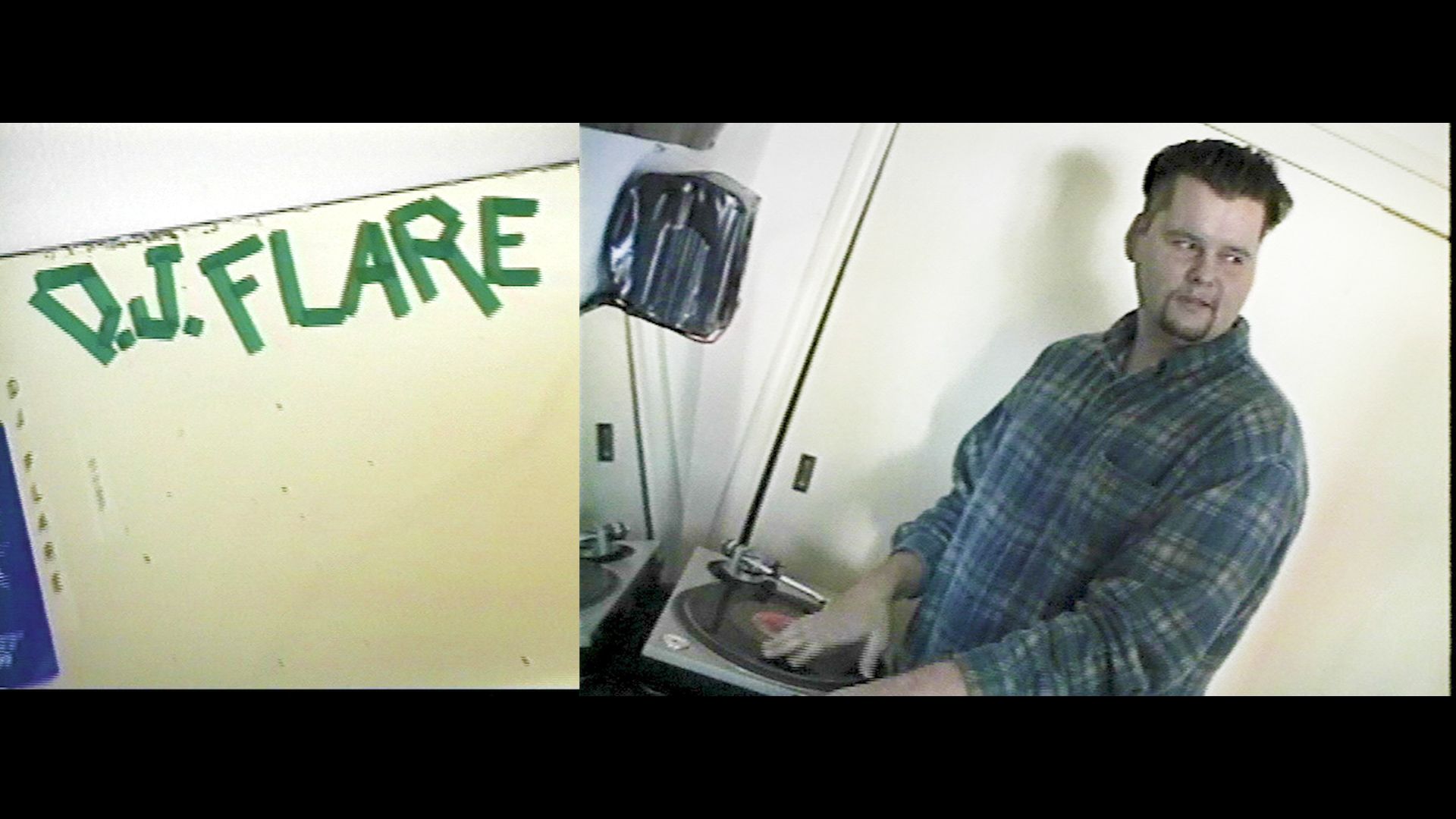
By 1993 most of the DJ world thought every scratch had been created. Certainly there where tons on new combinations and different sound that could be used, but overall it came down to your basic rubs, chops, cuts, chirps and the famous transformer scratch. DJs tried new things, but the idea of creating new scratches was truly unheard of. Then came along a chunky surfer dude from the bay area name DJ Flare, marking an innovation that has stood the test of time.
"I was thinking of way to make a scratch," explains DJ Flare. "I heard transforming and stuff and it wasn’t like really quick. It was fast, but not really fast, and I wanted to create something that was really fast. So I was just messing around and (I found that) transforming is like straight continuous, you know, so I was thinking of breaking it down into little clicks. I didn’t think much of it. I just thought it was just another scratch, until I started showing it to other DJs and other DJs where like 'damm'".
DJ Q-bert explains his first reaction "(I was like) what the f** is that"? "Me and DJ Disk use to call it the haunt scratch, because it would haunt us- how the f*** is doing that?
DJ Babu breaks down some of the mystery. "To me to get that scratch it took me like two months, I broke all my habits, I had to break everything and re-learn my own style of scratching". "If know the basic scratching, the fader and the hand move together, like chops, jabs or chirps, it like your hands are synchronized, but when you’re doing The Flare scratch it almost like the first doing this", Babu begins taps his head with one hand, rubbing his stomach with the other and laughs. Emphasizing the un-synchronized hand movements Bubu further explains "the cut is like syncopated, you are cutting off beat almost to catch that scratch, it’s just awkward compared to traditional styles of scratching."
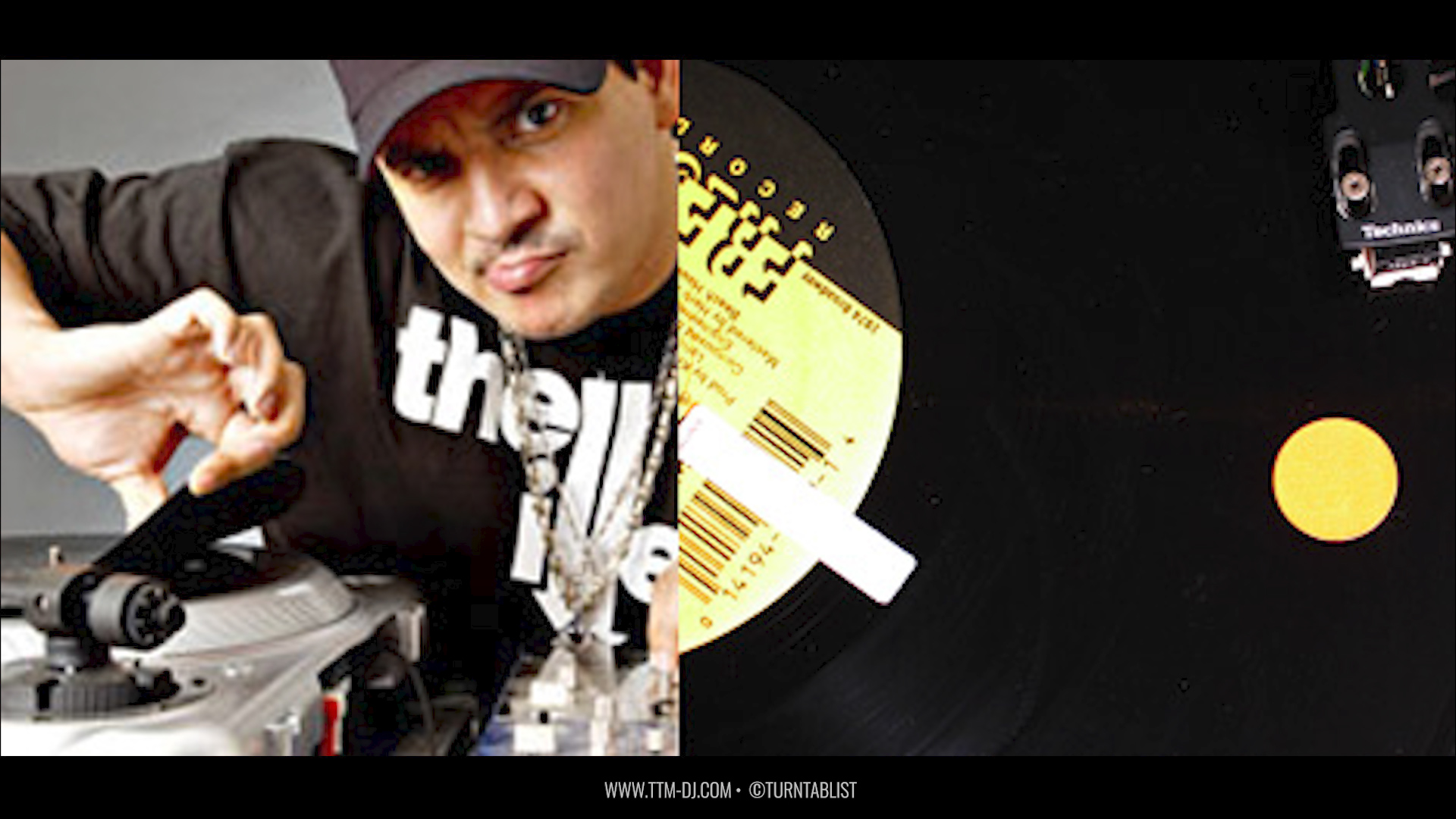
DJ TIP:
STICKERING YOUR RECORDS with MIX MASTER MIKE
( from Scratch Magazine 2005)
So you have a kick, a beat, a horn hit, -- how do you find it? Well those stickers plastered all over a turntablist’s record do have meaning. Whether it’s a cue at the start of a song or a groove in the middle of the record that you may want to skip (on purpose, of course) to locate an exact spot without using headphones, there is actually a method to the madness. Mix Master Mike, resident Beastie Boys DJ, explains.
1. Generally, I go with either a red or green Avery dot. The green sticker represents a beat idea or throw in, and the red sticker represents specific sounds to scratch.
2. For cueing, I usually use a Garbage Pale Kid sticker or Liquid Paper.
3. For trying to make the record skip, make sure the sticker’s edges are secured flat so the groove loops successfully.
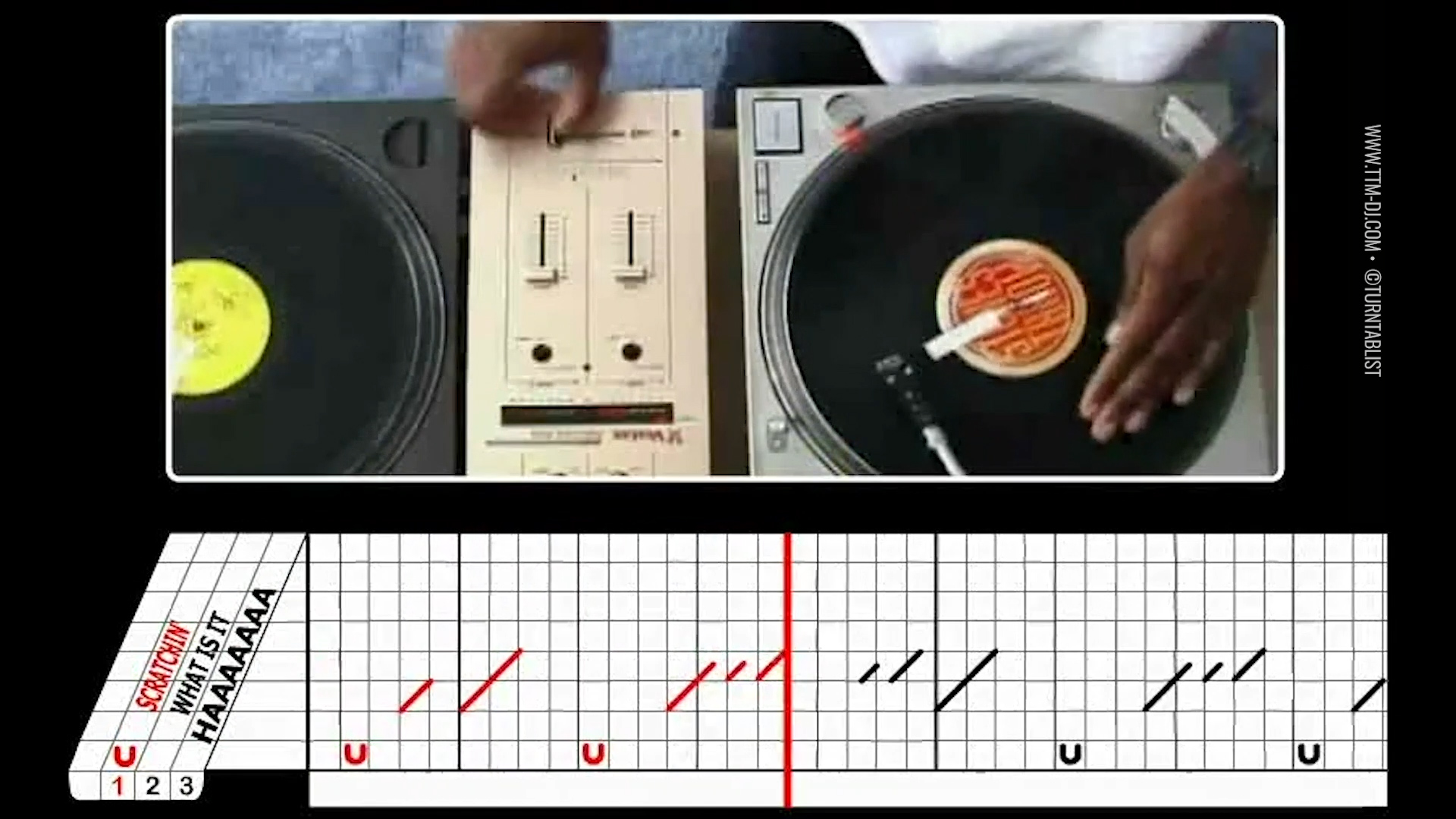
Here is an example of DJ scratch routine by DJ Rob Swift. It illustrates some the latest scratch trends of the late 90s.
TECHNICAL NOTE:
The mixer line contains details of how he is using Turntable #2.
Rob does crab scratches in Verse3.
A pattern in Verse 4 repeats itself 3 times.
Download this transcription in the TTM booklet.
Video By Turntablist, LLC, re-edit by DJ SKAR (http://easyttm.com)
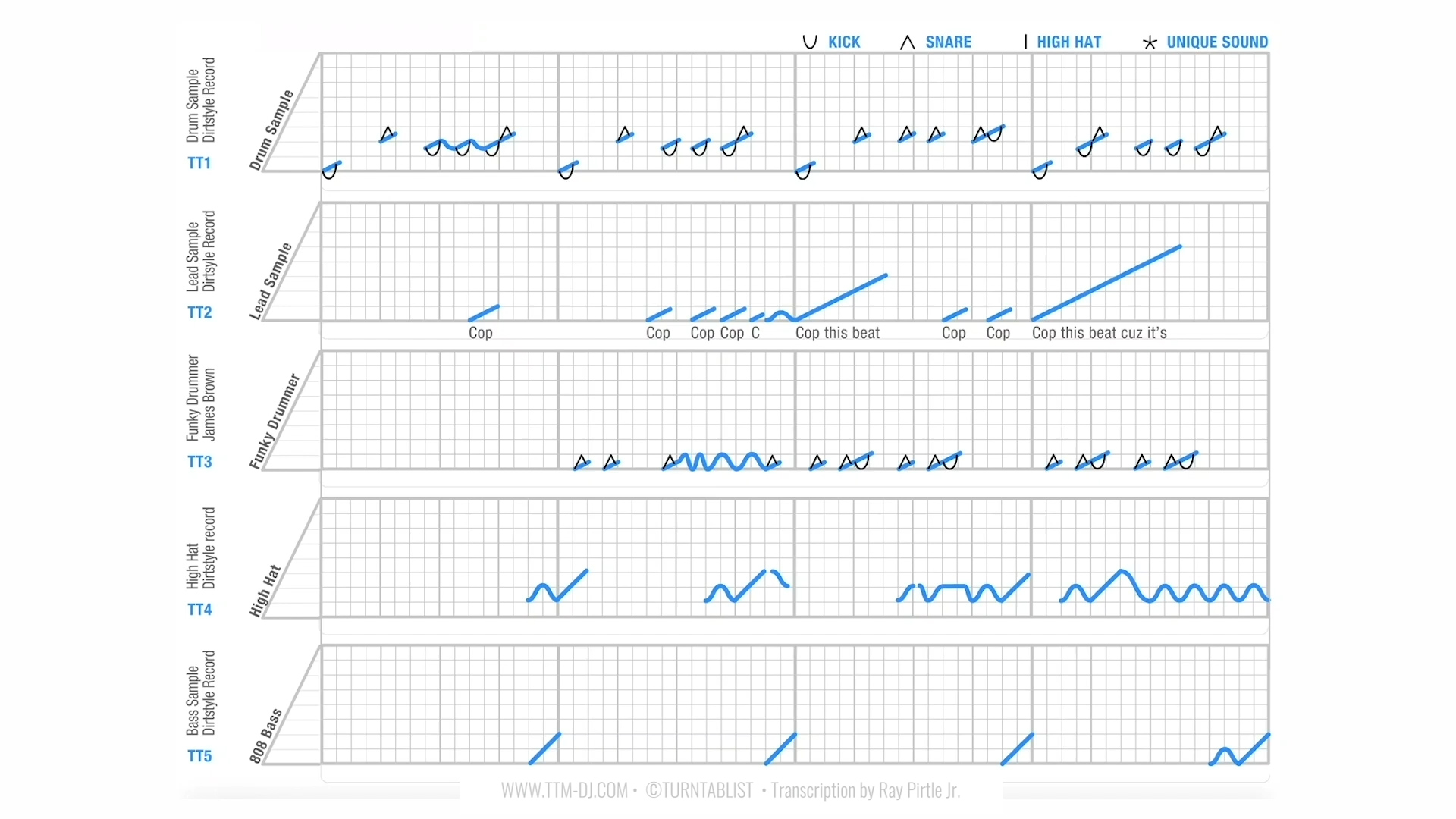
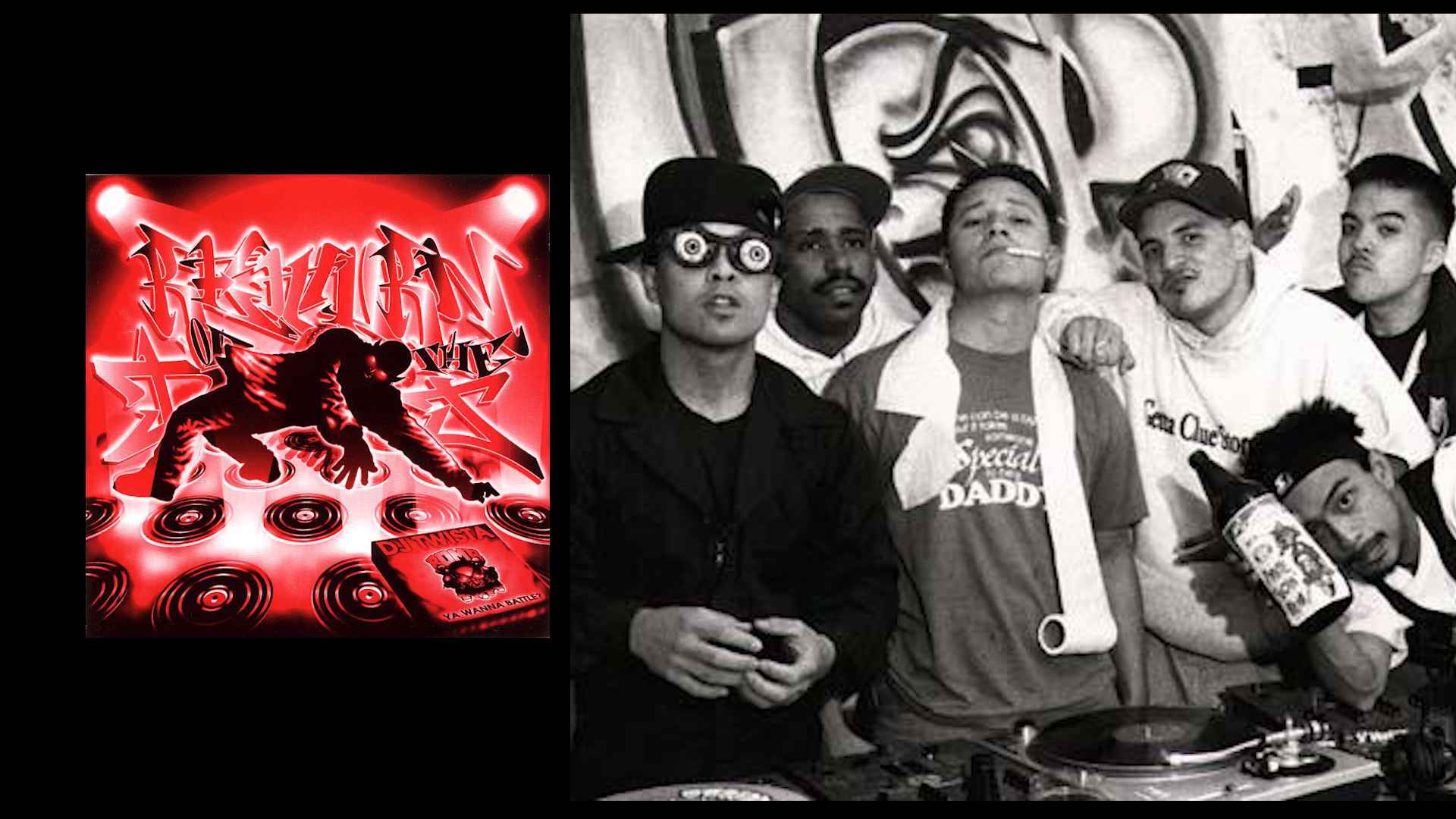
In 1994, David Paul of THE BOMB, A San Francisco based Hip-Hop journal, started collecting submission for a DJ only album entitled Return of The DJ. It would showcase all the amazing original music he was hearing on scratch mix tapes and at DJ battles. The idea of doing a DJ track was nothing new for Q-bert, who at the time called his style of DJing "Turntable Jazz". But, Q wanted to do make sure he did something different for his submission.
Qbert describes the evolution of his track, "I pretty much did the whole thing track by track as an experiment to see what would happen if every sound was skratched, since I had never heard of a whole song with every instrument being skratched".
"I started off with the drums skratched. Then the cymbals, then 808 bass skratched, then a little James Brown Funky Drummer sounds skratched, then added the (accent) scratches and more sound effect type skratches . I left two open spots for my two closest skratch pals DJ Disk and DJ Shortkut, who at the time lived close by in my hood"
The result was an all turntable track, nothing programmed – all live. In fact Disk, Short and Q have performed the track live. A key component of this arrangement is "the drumming" done by skratching a kick and a snare – a standard technique for crews of DJs who jam together for hours on end. Opting not to sample, Q-bert explains his rhythmic challenge, "I'd have to say the hardest part was doing the drumming, because it had to be really on time or it wouldn't sound right,".
"When it was all done I showed it to Dave Paul and I was worried that all the other submissions for his compilation were going to blow mine away," Q-bert says with a laugh, "It was just an experiment that turned out alright".
Nowadays, Q-bert has reached a legendary status in the turntablist worlds for his development in scratch language with his endless techniques and promotion of the art form (ScratchCon, Dirtstyle records, Wave Twisters, Thud Rumble). Invasion of the Octopus People is one Q-bert’s first commercially available recordings.
___
In the evolution of Hip-hop Deejaying there are some clear cue points. Each revolution occurring when a DJ or DJs from outside the established circle has blasted open its own entry into the scene. These DJs usually have nothing to lose and more to gain, as they broke ground with a fresh perspective that being outside the loop had imparted them.
The obvious first wave came in the way of New York (Herc, Bam, Flash, DSt, Theodore, etc.) breaking the norm set by the disco DJ, then Philadelphia (Jazzy Jeff, Cash Money) with it’s innovative Transformer and rhythm scratching styles, along the way Los Angeles (Joe Cooley, Aladdin) marked it’s place with its high speed patterns, New York returned with body tricks (DJ Scratch, Daddy Rich) and advancements in beat juggling (Steve Dee & The X-men) then by 1992 the Bay Area scene (Q-bert, Mix Master Mike) broke down the doors. So much so, that these talents evolved beyond the normal qualifications of a Hip-Hop DJ, thus emerging the term Turntablist.
Q-bert, a product of the Bay Area mobile DJ scene, is a notorious turntablist rebel who has consistently challenged the established norms. One look at his 1991 DMC battle routine with its ultra fast scratching, tone making, quick back spins and experimental needle usage, it was clear that this little dude would have a big effect. As he breaks down all limits, his creative spirit hasbecome firmly marked and his influence continues to be felt.









